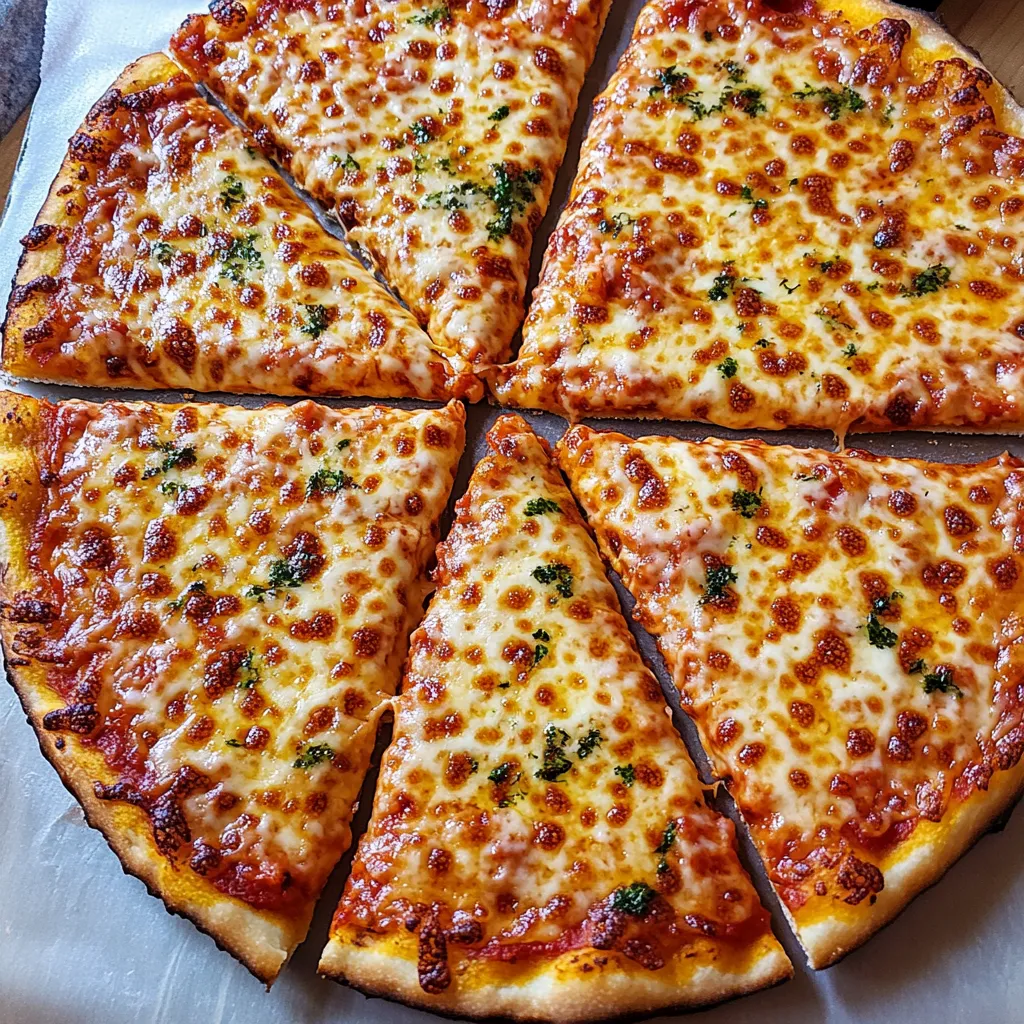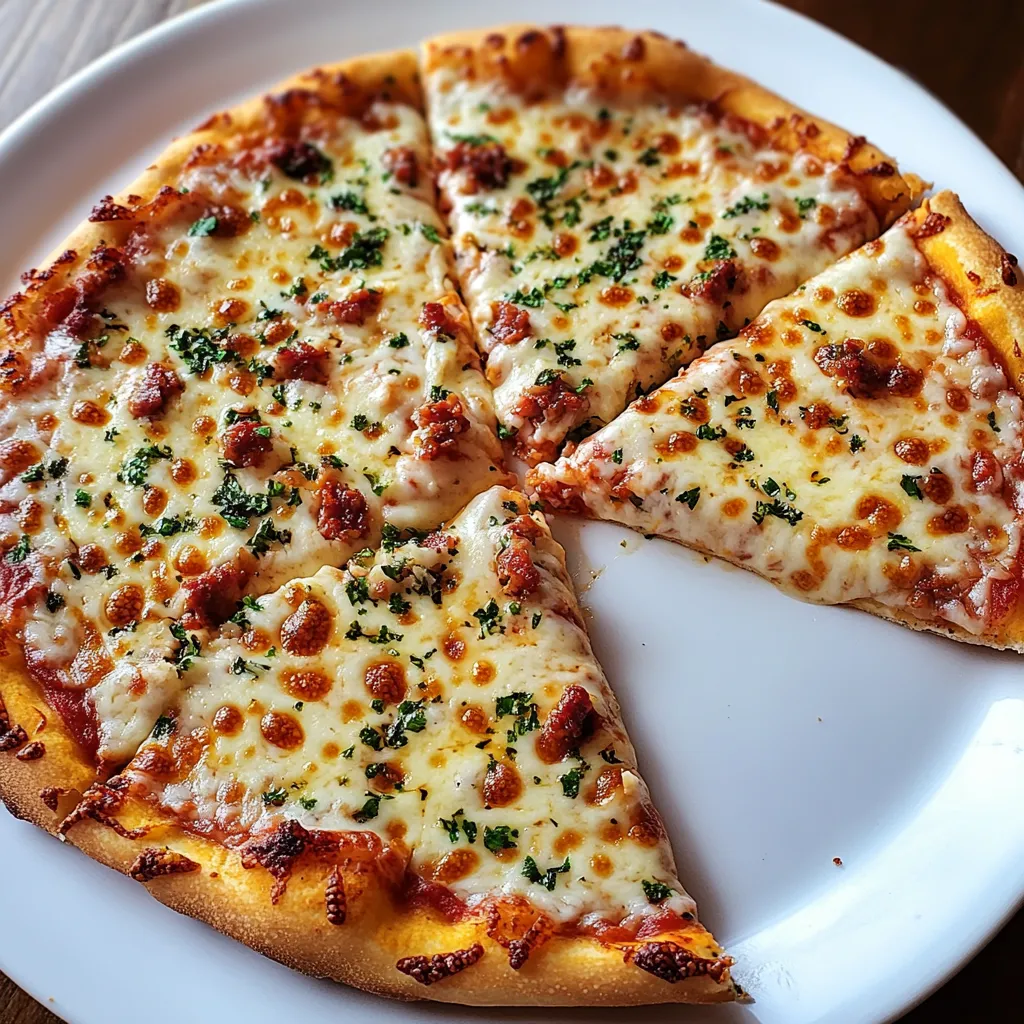 Pin it
Pin it
This South Shore Bar Pizza recipe recreates the iconic thin-crust, pan-baked pizza famous throughout Massachusetts' South Shore region. With its perfectly caramelized edges and distinctive three-cheese blend, this pizza delivers an unforgettable taste experience that brings a beloved local tradition right to your home kitchen.
I first encountered South Shore Bar Pizza during a summer trip to Massachusetts and became obsessed with recreating that distinctive charred edge and cheese blend at home. After months of testing, this recipe finally captures the magic that makes these bar pizzas so addictive.
Ingredients
- Water: 98-100°F, serves as the foundation for activating the yeast properly and creating the perfect dough consistency
- Dry active yeast: Provides the necessary rise without overwhelming the thin crust texture
- Granulated sugar: Helps feed the yeast and promotes proper browning of the crust
- All-purpose flour: Works best for this style rather than bread or pizza flour for the right texture
- Extra virgin olive oil: Adds flavor to the dough and prevents sticking in the pan
- Table salt: Enhances flavors and strengthens the dough structure
- Pastene California Pizza Sauce: Offers the authentic taste many South Shore pizzerias use
- Aged cheddar cheese: The distinctive element that sets this pizza apart from typical pizzas
- Fresh mozzarella: Provides the stretchy cheese pull everyone loves
- Freshly grated Parmesan cheese: Adds depth and saltiness to the cheese blend
Step-by-Step Instructions
- Prepare the Yeast Mixture:
- Combine 98-degree water with yeast and sugar in your stand mixer bowl. Allow it to sit for 5-10 minutes until foamy, which indicates the yeast is alive and active. This step is crucial for proper fermentation and the characteristic flavor development in the dough.
- Create the Dough Base:
- Alternate adding flour and oil to the yeast mixture with the mixer on low speed. Do not add salt yet as it can inhibit yeast activity. The gradual addition ensures proper incorporation without developing too much gluten too quickly, which would make the dough tough.
- Initial Kneading:
- Mix on medium-low for exactly four minutes to begin developing the gluten structure. The dough should stick slightly to the bottom of the bowl as it mixes. This tackiness indicates the right hydration level for a South Shore Bar Pizza crust. Adjust with small amounts of water or flour until reaching this perfect consistency.
- Add Salt and Complete Kneading:
- Incorporate the salt after the initial kneading and continue mixing for four more minutes. This two-stage kneading process allows the yeast to properly activate before introducing salt, resulting in better fermentation. The dough will be somewhat sticky to touch but developed enough to hold together.
- First Proofing:
- Transfer the dough to an oiled bowl, cover, and let rise until doubled in size, approximately two hours. This initial fermentation develops flavor compounds and begins creating the airy structure within the dough.
- Portion and Cold Ferment:
- Punch down the dough to release carbon dioxide, then divide into two 6-ounce balls. Place each in a sealed sandwich bag and refrigerate overnight. This slow, cold fermentation is essential for developing the complex flavors that distinguish authentic South Shore Bar Pizza.
- Prepare Cheese Blend:
- Combine the three cheeses, cover, and refrigerate until needed. This unique blend with aged cheddar is what gives South Shore Bar Pizza its distinctive flavor profile and perfect melt characteristics.
- Preheat and Setup:
- One hour before baking, heat your oven to 450°F with a pizza stone on the lowest rack. The stone creates the intense bottom heat needed for proper crust development. Place another rack in the top position for the final baking stage.
- Shape the Dough:
- Remove dough from refrigeration and form into neat balls. Place a half teaspoon of olive oil in each pizza pan and spread to the edges. Working with patience, gradually press the dough outward toward the pan edges, allowing rest periods between stretches. This slow process prevents tearing and ensures even thickness.
- Create the Edge:
- When the dough reaches the pan edges, press up the sides slightly about a quarter inch. This small rim will contain the sauce and cheese while creating the opportunity for the famous laced edge if desired.
- Add Sauce and Cheese:
- For the traditional laced style, bring sauce right to the pan edge and mound it slightly on the rim, followed by generous cheese that will caramelize during baking. For a non-laced version, keep sauce and cheese slightly away from the edge. Either way, use the precise measurements indicated for authentic results.
- Two-Stage Baking:
- Begin by placing the pans directly on the stone for ten minutes to develop the bottom crust. Then transfer to the top rack to finish baking for another 8-10 minutes. This two-location baking method ensures the proper contrast between crisp bottom and perfectly caramelized top.
 Pin it
Pin it
The aged cheddar cheese is what truly sets this pizza apart from typical pizzeria offerings. I was skeptical at first about using cheddar on pizza, but that first bite with its sharp, nutty flavor combined with the gooey mozzarella completely changed my perspective. Now my family requests this pizza at least twice a month.
The Laced Edge Phenomenon
South Shore Bar Pizza is famous for its laced edge where sauce and cheese intentionally overflow to create a crispy, caramelized rim. This technique produces a concentrated flavor bomb around the circumference that many enthusiasts consider the best part of the pizza. The secret is getting the sauce right to the edge and allowing the cheese to make contact with the hot pan during baking. The result is a distinctive charred, crispy edge that provides textural contrast to the tender center.
Making Ahead Options
While the dough requires overnight refrigeration, you can extend this cold fermentation for up to three days for even more developed flavor. Additionally, the formed dough in pans can be refrigerated for several hours before baking, making this recipe perfect for advance preparation before parties. The cheese blend can be mixed up to two days ahead, though shredding the cheeses just before mixing will ensure the freshest flavor and best melting properties.
Regional Variation: The Pizza Topper
In South Shore bars, this pizza is famously served with a small cup of cold, sweet tomato sauce on the side called a pizza topper. Some patrons dip their pizza into this sauce while others pour it directly onto their slice. To make an authentic topper, mix 1/4 cup tomato puree with 1 tablespoon sugar and a pinch of oregano. Serve chilled alongside your pizzas for the complete South Shore experience.
 Pin it
Pin it
This recipe ensures you can experience the authentic taste of South Shore Bar Pizza with all its distinctive qualities right from your own kitchen.
Frequently Asked Questions
- → What makes South Shore Bar Pizza different from regular pizza?
South Shore Bar Pizza is distinguished by its thin crust, pan-baked preparation, and deeply caramelized edges. It features a unique three-cheese blend of aged cheddar, fresh mozzarella, and Parmesan cheese, rather than just mozzarella. The 'laced' style, where cheese and sauce intentionally caramelize around the edges, creates a signature crispy finish that's characteristic of this regional specialty.
- → What does 'laced' mean for South Shore Bar Pizza?
'Laced' refers to a technique where sauce and cheese are intentionally spread to the pan's edge, allowing them to overflow slightly and caramelize during baking. This creates crispy, darkened edges that many consider the best part of the pizza. For laced pizza, sauce is mounded at the edges and extra cheese is added to those areas to enhance the caramelization effect.
- → Why does the dough need to rest overnight?
The overnight refrigeration allows for slow fermentation, which develops complex flavors in the dough and improves its texture. This cold proofing process makes the dough more manageable when stretching it to fit the pan and results in a better-tasting crust with ideal chewiness and structure.
- → Can I use pre-shredded cheese for this pizza?
For authentic results, it's best to avoid pre-shredded cheese, which contains anti-caking agents that affect melting quality. The recipe specifically recommends shredding fresh mozzarella yourself and using specific aged cheddar for optimal flavor and melt. The cheese blend is crucial to achieving the distinctive taste and texture of genuine South Shore Bar Pizza.
- → What's the purpose of using a pizza stone for this style?
The pizza stone provides intense bottom heat that helps create the crispy base characteristic of South Shore Bar Pizza. The stone maintains consistent high temperature and absorbs moisture from the dough, which is essential for proper crust development. The two-stage baking process (bottom rack then top rack) allows both proper crust formation and perfect cheese caramelization.
- → What toppings work best on South Shore Bar Pizza?
While traditionally enjoyed with minimal toppings to showcase the cheese blend and crust, common additions include pepperoni, linguica (Portuguese sausage popular in the region), mushrooms, or onions. Toppings should be applied sparingly to maintain the thin-crust character and ensure even baking. Some authentic South Shore pizzerias offer a 'bar pie special' with multiple toppings, but the cheese-forward approach remains most popular.
